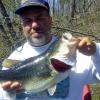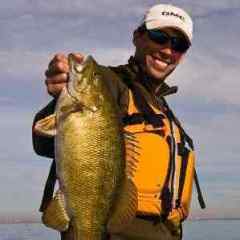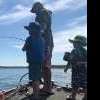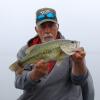Take a look at your average water temperatures. Water temps of 32-39 degrees are what bass under the ice are going to experience. 32 degrees right against the ice,and progressively warmer toward the bottom. In lakes, the warmest water is going to be close to the bottom, about 38-39 degrees. Water is at it's lightest at or below 32 degrees. That is why ice floats. But until it freezes, it will sink as it cools. So the water close to the ice gets heavy and sinks to the bottom, warms up against the bottom, and rises until it hits the ice and cools off again. This is one of the reasons why the most actively feeding fish are going to be close to the bottom of a lake or pond. The bottom is the warmest part of a lake in the winter, the reverse of summer pattern when the warmest water is at the surface. Digestion drastically slows down as the fish's body temperature cools down close to the freezing point. A meal that would take a bass 8 hrs to digest in the summer now takes a week to digest.. That actually works out OK as most of the food is dormant, under rocks, leaves and buried in the mud. Since the fish mostly congregate in the same deep holes, competition gets pretty fierce, and even though food needs are much lower, it is also harder to find food so the fish will still feed. In my experience, when you find those deep holes the fish can be stacked up. If you catch one, stick around and try a few presentations until you get bit again.I am perplexed by states like Pa that have liberal limits on bass caught through the ice. Once you find these fish, it isn't hard to clean out a lake. Although a reaction strike may get one or two fish, you will find that slow subtle finesse presentations will win the day. Bites tend to be very light and many if not most will happen on a dead stick. Although the fishing slows pretty drastically in temperate lakes, the water temperature isn't far outside of a basses comfort zone, if you slow down your presentation and fish close to or on the bottom, once you find fish, they can be caught.
Rivers are different though. Since they are constantly flowing, they have much less convection effect warming them up. So until they start to freeze, the temps continue to drop until the water is just barely above the freezing point. Deep holes will be approximately the same temp as shallow water, at least below rapids where any stratification has been mixed up by the turbulence. If you question this, take a look at colder norther rivers where it is common to see anchor ice forming. this is when the bottom is cold enough for the ice to freeze as a coating on the submerged rocks, boulders and gravel forming the river bottom. At these temps, most fish can barely digest food at all. Metabolism slows down to a crawl. Yet some of the fish will still feed. Walleyes are well adapted to low temps and can be very aggressive at 32.1 degrees. Yellow perch and pickerel, to a lesser extent also seem to be able to deal with extremely low temps. When it comes to the bass family, I find they tend to turn off at about 34 degrees. I will occasionally catch a smallmouth bass in 32.1 degree water, but I would say it is somewhat unusual. You can find fish stacked up and they will not bite, even bait. They do not need to feed. The food will rot in them before it digests.
There are some other factors influencing fish location and behavior in winter, like light, weed growth, oxygen levels and current Put all of those factors together and you will have a good start at locating wintering fish in your local waters.




